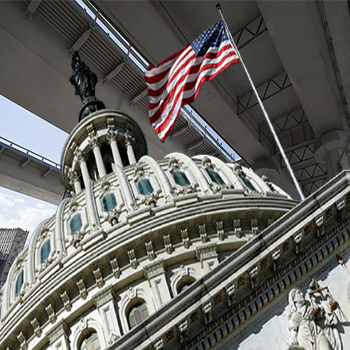Agreement Reached on 5 Year Transportation Bill

Congress ended weeks of contentious negotiation Tuesday, agreeing to a five-year $281 billion transportation bill that will boost spending on roads and transit systems by billions each year.
The House and Senate have reached an agreement on a 5-year, $281 billion transportation bill that would increase spending to address the nation’s aging and congested highways and transit systems.
This is a legislative feat that lawmakers and President Barack Obama have struggled throughout his administration to achieve.
The bill, unveiled Tuesday, would also put an end to the cycle of temporary extensions and threatened shutdowns of transportation programs that have bedeviled Congress for the past seven years, making it difficult for states to plan long-term projects.
The 1,300-page measure was “a mammoth task,” said Sen. Barbara Boxer, D-Calif., one of the bill’s key negotiators.
“I expect this bill to have a huge amount of support throughout the country from businesses and workers alike,” she said in a statement.
“Although it is not perfect, I believe it is a major accomplishment for our people who expect us to fund a top-notch transportation system” - Senator Barbara Boxer
The bill boosts highway spending by 15 percent and transit spending by 18 percent over its duration. It also authorizes $10 billion over five years for Amtrak, $12 billion for mass transit and $1 billion for vehicle safety programs.
However, that money is subject to annual spending decisions by Congress rather than being paid for from the federal Highway Trust Fund.
The bill still falls far short of the $400 billion over six years that Transportation Secretary Anthony Foxx has said is needed to keep traffic congestion from worsening, and it puts off the difficult decision of how to sustainably pay for transportation programs.
The federal 18.4 cents-a-gallon gas tax, the main source of Trust Fund revenues, hasn’t been increased since 1993 and no longer covers annual spending on transportation.
The House and Senate must still vote on the final bill. Passage is expected by Friday, when government authority to process aid payments to states expires.
The bill is paid for through a series of revenue-raising provisions, some of which have been criticized as gimmicks and budgetary sleight of hand.
One of the hallmarks of the bill is the creation of new programs to focus transportation aid on highways regarded as important “freight corridors” in an effort to reduce major bottlenecks and speed the delivery of goods.
One of the bill’s losers is the banking industry. It replaces the current 6 percent dividend the Federal Reserve pays to large banks with a floating rate tied to the 10-year Treasury note, which is expected to be less than 6 percent.
It also transfers about $49 billion over 10 years from a Federal Reserve capital account to the general treasury, counting the money as new revenue. Some lawmakers and a past Federal Reserve chairman say it is just a paper transfer that actually raises no new money.
“Banks shouldn’t be used like an E-Z Pass to pay for highways,” said Rob Nichols, president of the American Bankers Association.
Safety advocates lost several fights, but won some others:
- The Federal Motor Carrier Safety Administration must remove safety scores for trucking companies from a public website, but the agency can continue to post scores for tour bus and interstate bus operators. The truck and bus industries say the government’s methodology for determining the scores is unfair; safety advocates say the scores are a useful safety indicator.
- The maximum fine the National Highway Traffic Safety Administration can levy against an automaker who withholds information on safety defects would triple from $35 million to $105 million per violation.
- Pilot programs in the Senate and House bills that would have allowed 18 and 19-year-olds to drive big trucks and buses across the country are significantly scaled back. The programs would be limited to military reserve members and veterans who have received training.
- Rental car agencies and car dealers with fleets of more than 35 cars would be prohibited from renting vehicles that have been recalled but not repaired, a long-sought goal of safety advocates. But the bill doesn’t require used-car dealers to repair recalled vehicles before selling them, and it doesn’t prohibit new- and used-car dealers from loaning unrepaired vehicles to customers.
- About $200 million is provided to help commuter railroads install positive train control technology to prevent collisions and derailments. Federal investigators say if the technology had been in operation a deadly Amtrak derailment in Philadelphia in May could have been prevented.
- The liability cap on passenger rail accidents is raised from $200 million to $295 million. Damage awards from the Amtrak derailment, which killed eight people and injured about 200, are expected to exceed the current cap.
The bill also retains $1.6 billion a year for transit programs in high-density Northeast states.
An amendment to the House bill would have diverted the funds to a grant program available to bus systems in all states.
Article Topics
FMCSA News & Resources
Under-21 driver pilot program a bust with fleets as FMCSA seeks changes Geographic bias, questionable data affect reliability of safety ratings, ATA tells FMCSA FMCSA issues final rule requiring $75,000 bond for brokers for claims FMCSA gives trucking interests additional 30-day comment period on safety regs FMCSA loosens HOS rules for truckers during emergencies, citing climate change OOIDA blasts FMCSA move to mandate speed limiters on heavy trucks Freight brokers oppose FMCSA push to require publishing rates More FMCSALatest in Transportation
FedEx Announces Plans to Shut Down Four Facilities The Two Most Important Factors in Last-Mile Delivery Most Companies Unprepared For Supply Chain Emergency Baltimore Bridge Collapse: Impact on Freight Navigating Amazon Logistics’ Growth Shakes Up Shipping Industry in 2023 Nissan Channels Tesla With Its Latest Manufacturing Process Why are Diesel Prices Climbing Back Over $4 a Gallon? More Transportation













